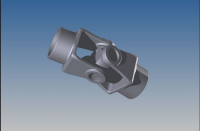A universal joint, (universal coupling, U-joint, Cardan joint, Hardy-Spicer joint, or Hooke's joint) is a joint or coupling in a rigid rod that allows the rod to 'bend' in any direction, and is commonly used in shafts that transmit rotary motion. It consists of a pair of hinges located close together, oriented at 90° to each other, connected by a cross shaft. The Universal joint is not a constant velocity joint.
The main concept of the universal joint is based on the design of gimbals, which have been in use since antiquity. One anticipation of the universal joint was its use by the Ancient Greeks on ballistae. The first person known to have suggested its use for transmitting motive power was Gerolamo Cardano, an Italian mathematician, in 1545, although it is unclear whether he produced a working model. In Europe, the device is often called the Cardan joint or Cardan shaft. Christopher Polhem of Sweden later reinvented it, giving rise to the name Polhemsknut in Swedish.
The mechanism was later described in Technica curiosa sive mirabilia artis (1664) by Gaspar Schott, who called it the paradoxum, but mistakenly claimed that it was a constant-velocity joint.Shortly afterwards, between 1667 and 1675, Robert Hooke analysed the joint and found that its speed of rotation was nonuniform, but that this property could be used to track the motion of the shadow on the face of a sundial.In fact, the component of the equation of time which accounts for the tilt of the equatorial plane relative to the ecliptic is entirely analogous to the mathematical description of the universal joint. The first recorded use of the term universal joint for this device was by Hooke in 1676, in his book Helioscopes.He published a description in 1678,resulting in the use of the term Hooke's joint in the English-speaking world. In 1683, Hooke proposed a solution to the nonuniform rotary speed of the universal joint: a pair of Hooke's joints 90° out of phase at either end of an intermediate shaft, an arrangement that is now known as a type of constant-velocity joint.
The term universal joint was used in the 18th century and was in common use in the 19th century. Edmund Morewood's 1844 patent for a metal coating machine called for a universal joint, by that name, to accommodate small alignment errors between the engine and rolling mill shafts.Lardner's 1877 Handbook described both simple and double universal joints, and noted that they were much used in the line shaft systems of cotton mills.Jules Weisbach described the mathematics of the universal joint and double universal joint in his treatise on mechanics published in English in 1883.
19th century uses of universal joints spanned a wide range of applications. Numerous universal joints were used to link the control shafts of the Northumberland telescope at Cambridge University in 1843.Ephriam Shay's locomotive patent of 1881, for example, used double universal joints in the locomotive's drive shaft.Charles Amidon used a much smaller universal joint in his bit-brace patented 1884.Beauchamp Tower's spherical, rotary, high speed steam engine used an adaptation of the universal joint circa 1885.
The term Cardan joint appears to be a latecomer to the English language. Many early uses in the 19th century appear in translations from French or are strongly influenced by French usage. Examples include an 1868 report on the Exposition Universelle of 1867 and an article on the dynamometer translated from French in 1881.








